|
|
|
Sort Order |
|
|
|
Items / Page
|
|
|
|
|
|
|
| Srl | Item |
| 1 |
ID:
163437
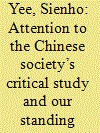

|
|
|
|
|
| Summary/Abstract |
1. In the June 2018 issue of this Journal, we published, as a special issue, the Chinese Society of International Law’s The South China Sea Arbitration Awards: A Critical Study (“Critical Study”, 17 Chinese JIL, 207-748). The Critical Study has received a great deal of attention online. We are most grateful.
2. Our Journal fully appreciates that readers of the Journal and authors of papers we publish may hold different views and that the papers we publish may receive a variety of critical responses. Our Journal considers it our mission to present such papers, as long as they meet our academic standards, as judged by peer reviewers. The Foreword to our very first issue
|
|
|
|
|
|
|
|
|
|
|
|
|
|
|
|
| 2 |
ID:
163435
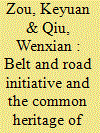

|
|
|
|
|
| Summary/Abstract |
With the development of global science and technology, the international legal concept of “the common heritage of mankind” (CHM) encounters some dilemma in practice. This editorial comment attempts to discuss the ongoing developments of the CHM concept in the context of the Belt and Road Initiative (BRI) put forward by China, and then the interplay between the two concepts. It is argued that the inherent elements of the CHM concept, such as co-management, co-benefit, and co-participation, are well reflected in the BRI. Moreover, the BRI can also reinforce the dynamic extension of the CHM concept in the above three key elements. As a new international public good, the BRI is aimed at reasonable allocation and sharing of international resources following the CHM concept, and correspondingly this concept can strengthen the theoretical basis of the BRI facilitating its entry into the centre of the international stage
|
|
|
|
|
|
|
|
|
|
|
|
|
|
|
|
| 3 |
ID:
163443


|
|
|
|
|
| Summary/Abstract |
The ICJ’s judgment on preliminary objections in Somalia v. Kenya touched new ground by ruling on such key provisions of UNCLOS as Articles 282 and 287. Its implications may go well beyond the present case. The Court ruled that the acceptance of its jurisdiction arising under Article 282 prevails over the selection of a preferred tribunal under Article 287 by election or by default. Some thought needs to be given to the manner in which the Court interpreted Articles 282 and 287. Instead of using the travaux préparatoires as a supplementary means to confirm the meaning resulting from the application of the general rule in Article 31 of the VCLT, the Court seemed to base the core of its interpretation on the travaux préparatoires. The Court’s interpretation of the relationship between Articles 282 and 287 in effect accords pride of place to itself. On a practical front, some States Parties of UNCLOS which have made optional clause declarations with reservations of various types may have to ponder what this Judgment means for them in the case of maritime delimitation disputes. Those States Parties which have not chosen the Court as its preferred forum or given it any prominence under Art. 287(1) will see their express choices of means of dispute settlement to be under a cloud, in light of the Court’s interpretation of Art. 282 in the present case.
|
|
|
|
|
|
|
|
|
|
|
|
|
|
|
|
| 4 |
ID:
163447
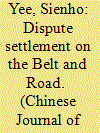

|
|
|
|
|
| Summary/Abstract |
This comment offers some brief observations on ideas that may promote the settlement of disputes that may arise from the Belt and Road Initiative, such as a possible standing investment court, a unified appellate mechanism or a legal aid mechanism as system components, a “lawyer for the situation” spirit for lawyering, an emphasis on a friendly style of dispute settlement, and a style of directly providing for rules of interpretation as part of the applicable law
|
|
|
|
|
|
|
|
|
|
|
|
|
|
|
|
| 5 |
ID:
163441
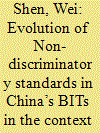

|
|
|
|
|
| Summary/Abstract |
The European Union (EU) and the People’s Republic of China (PRC or China) in January 2014 decided to launch negotiations on a bilateral treaty addressing the promotion and protection of investment between the two parties. This article mainly examines the legal positions from which the parties will proceed their negotiations in terms of the non-discriminatory standards, that is, the national treatment and the most-favored-nation treatment, which are said to be the cornerstone of foreign investment protection, by focusing on the evolution of non-discriminatory standards in China’s BITs against the same standards in the EU BITs, in particular, the EU’s recently concluded three important treaties regulating, among other things, foreign investment, namely with Canada, Singapore and Vietnam. Domestically, the reference value of BITs signed by China in the 1980s and 1990s has been significantly affected by the dynamic economic reform and market development in the past four decades. Essentially, globalisation has fundamentally lifted China’s foreign investment standards up to international standards. As a result, while the market anticipates the difficulties in the ongoing negotiations, the gap between the EU and China, as argued in this article, should be noticeably slight when the EU and China come to negotiate the non-discriminatory standards.
|
|
|
|
|
|
|
|
|
|
|
|
|
|
|
|
| 6 |
ID:
163444
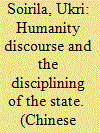

|
|
|
|
|
| Summary/Abstract |
Since the end of Cold War, international legal discussion and practice has been increasingly permeated by what this article calls “humanity discourse”. The article analyzes the discourse from a critical perspective. The main argument of the article is that the humanity discourse contributes to what Anne Orford has called the “battle for the State”, and consequently to the neoliberal project which is now a hegemonic power in global law and policy. This argument is supported both by an analysis of humanity discourse in academic discussions and an analysis of how humanity language has been used in practice.
|
|
|
|
|
|
|
|
|
|
|
|
|
|
|
|
| 7 |
ID:
163446
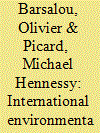

|
|
|
|
|
| Summary/Abstract |
In an era of globalized waste, international environmental law’s main function is not simply to protect and preserve nature and the environment. Rather, it should be conceived of as a set of norms, institutions, and practices designed to manage waste on a global scale.
|
|
|
|
|
|
|
|
|
|
|
|
|
|
|
|
| 8 |
ID:
163439
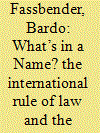

|
|
|
|
|
| Summary/Abstract |
In the past twenty years or so, the concept of the rule of law, cherished for centuries as a constitutional principle in a domestic legal context, has attracted much attention from international lawyers and international organizations. In particular, the United Nations has devoted substantial effort and time to studying and defining the international dimension of the concept, to concretizing specific legal consequences, and to applying the concept to its own mandate and work, especially in the area of the maintenance of international peace and security. Against this background, the present article enquires into the relationship between the concept of an international rule of law as advanced by the United Nations and the UN Charter. To what extent can the concept be said to be inherent in the Charter, although the term itself does not appear in its text? Comparing the original design of the Charter with the rule of law as developed by the UN, the article observes a progressive expansion of the concept in several dimensions, but at the same time its persistent vagueness.
|
|
|
|
|
|
|
|
|
|
|
|
|
|
|
|
|
|
|
|
|